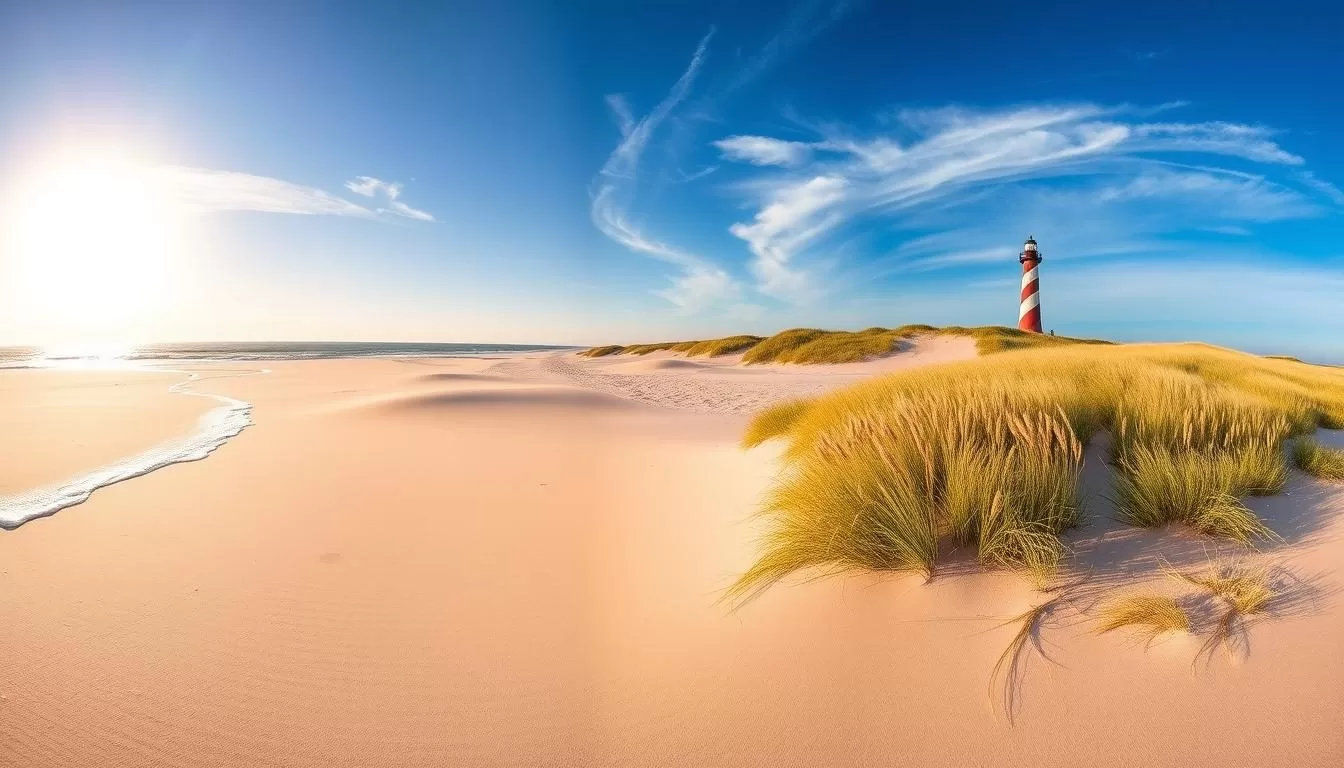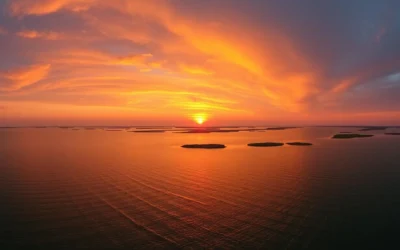✓ Accommodations✓ Flights✓ Rental Cars
Imagine a place where the natural beauty of the coastline meets rich history and exciting outdoor adventures. You’re invited to explore Cape Hatteras National Seashore, a 70-mile stretch of pristine coastline in North Carolina’s Outer Banks. This stunning destination attracts nearly a million visitors each year, offering a perfect blend of relaxation and adventure.
As you visit this incredible national park, you’ll discover iconic lighthouses, award-winning beaches, and a diverse range of outdoor activities. The seashore encompasses three unique islands: Bodie Island, Hatteras Island, and Ocracoke Island, each with its own character and attractions. Whether you’re planning a quick getaway or an extended vacation, Cape Hatteras National Seashore is a must-visit destination.
Discovering the Coastal Gem of North Carolina
The Outer Banks’ crown jewel, Cape Hatteras National Seashore, beckons with its unspoiled beauty. As the nation’s first national seashore, established in 1937 and officially dedicated in 1958, it continues to be one of the largest preserved coastal areas in the United States.
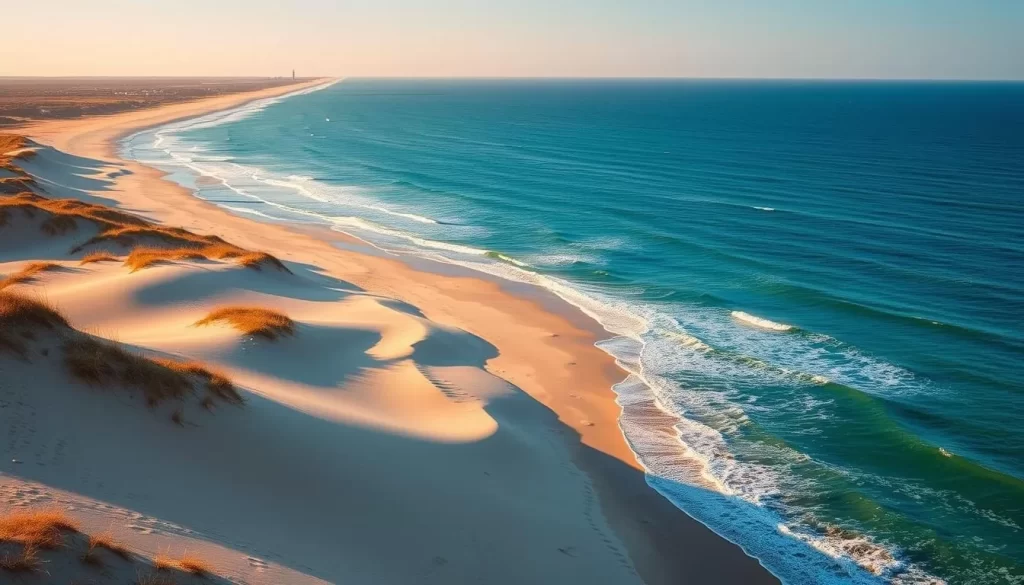
Spanning 70 miles from Oregon Inlet to Ocracoke Inlet, Cape Hatteras National Seashore provides visitors with endless opportunities to explore pristine beaches, maritime forests, and coastal marshlands. Unlike many coastal destinations, it maintains its wild, natural character with limited development, allowing you to experience the Outer Banks as they have existed for centuries.
The area’s unique geography creates diverse ecosystems where you can observe wildlife, enjoy water activities, or simply relax on uncrowded beaches away from commercial development. With nearly a million visitors annually, the seashore remains uncrowded due to its vast size, ensuring you can always find a peaceful spot to enjoy the natural beauty of the North Carolina coast.
Cape Hatteras National Seashore is a hidden treasure tucked away in the Outer Banks of North Carolina, offering a perfect escape from busy city life with its unspoiled beach and natural landscapes.
The Rich History and Geography of Cape Hatteras National Seashore
As you explore Cape Hatteras National Seashore, you’ll uncover a deep history and dynamic geography that have captivated visitors for centuries. The area’s story begins with the Native Americans from the Algonquin Tribe, who established thriving communities along what they called “Hatterask.”
By the 1600s and 1700s, European settlers were drawn to the Outer Banks for its abundant seafood, quality timber from maritime forests, and strategic location with access to mainland North Carolina through Hatteras and Ocracoke Inlets. The area’s unique geography, with its barrier islands, has been shaped by the constant forces of wind and water erosion, creating a landscape that continues to evolve.
![]()
The Cape Hatteras National Seashore earned its nickname “Graveyard of the Atlantic” due to the treacherous Diamond Shoals and churning waters created by the meeting of the Gulf Stream and Labrador Current, resulting in over 2,000 shipwrecks along the coast. In response to these frequent maritime disasters, lifesaving stations were established throughout the seashore, becoming a crucial part of the area’s maritime history and eventually evolving into the U.S. Coast Guard.
The geography of Cape Hatteras National Seashore is characterized by its barrier islands, which are constantly shifting due to natural forces. In the 1930s, locals partnered with the federal government to establish the National Seashore, donating and selling land to ensure the coastline would remain undeveloped and preserved for future generations to enjoy. Spanning over 72 miles of coastline, the area offers a unique blend of natural beauty and historical significance.
Explore the Iconic Cape Hatteras Lighthouse
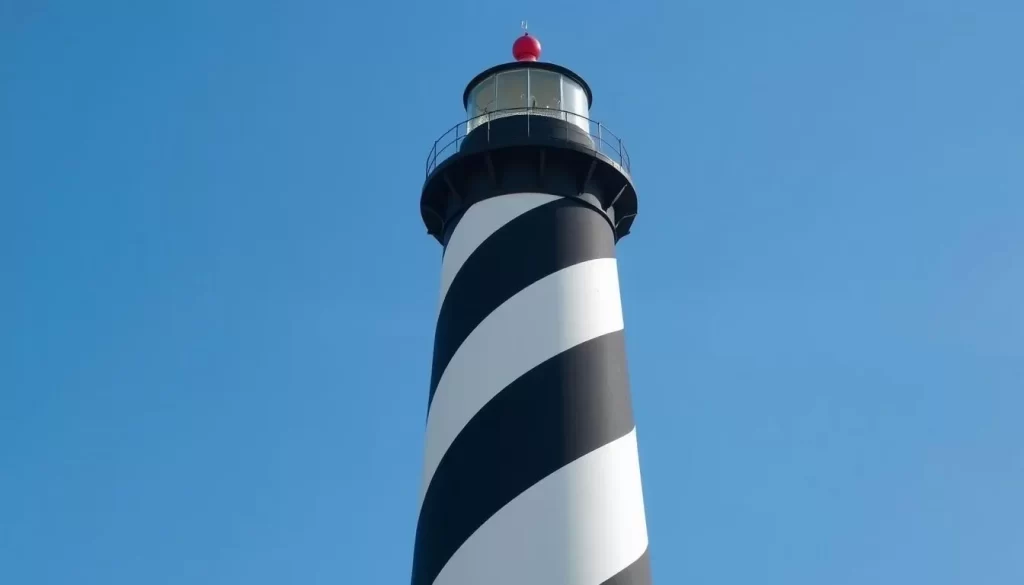
As you explore the Outer Banks, the Cape Hatteras Lighthouse is a historic gem you won’t want to miss. Standing at an impressive 198.49 feet (60.5 meters), it is the tallest lighthouse in the United States. Constructed with over 1.25 million bricks, its iconic black and white spiral design makes it instantly recognizable.
Built in 1870, the Cape Hatteras Lighthouse replaced an earlier, less effective lighthouse from 1803. This maritime beacon has guided countless ships safely through the treacherous waters known as the “Graveyard of the Atlantic.” Climbing the 257 steps to the top rewards you with breathtaking panoramic views of Hatteras Island, the Atlantic Ocean, and Pamlico Sound—a must-do experience for any visitor to the Outer Banks.
In 1999, the Hatteras Lighthouse underwent a remarkable engineering feat when it was moved 2,900 feet inland to protect it from shoreline erosion, preserving this historic landmark for future generations. While climbing opportunities are currently limited due to restoration efforts, the lighthouse grounds remain open and offer excellent photo opportunities, educational exhibits, and a chance to learn about the area’s maritime history.
After exploring the lighthouse, you can relax at the nearby Old Lighthouse Beach, a popular spot for surfing and swimming, with lifeguards on duty during summer months. This makes it a perfect place to unwind after visiting this iconic landmark. As visitors to the Cape Hatteras area, you’ll find that the combination of history, natural beauty, and recreational activities makes for an unforgettable experience.
Bodie Island Lighthouse: A Historic Maritime Beacon
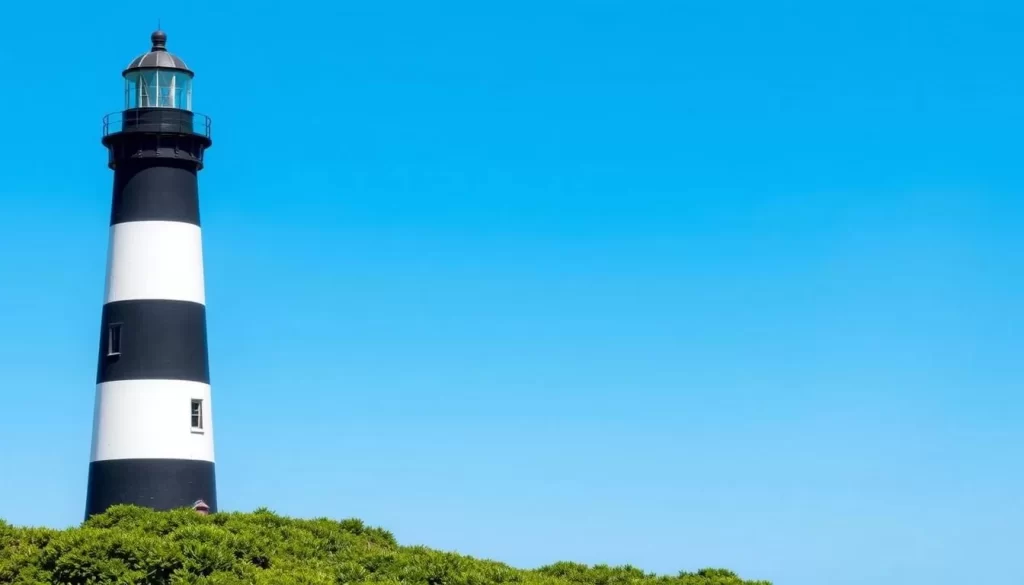
The Bodie Island Lighthouse, standing tall with its distinctive black and white stripes, is a historic maritime beacon worth exploring. Located near the northern entrance to Cape Hatteras National Seashore, it serves as an excellent first stop for visitors approaching from the north.
Built in 1872, the Bodie Island Lighthouse is actually the third lighthouse to stand in this location, with previous structures dating back to 1847 and 1859. The current lighthouse stands 156 feet tall and features a striking black and white horizontal striped pattern, distinguishing it from other lighthouses like the Cape Hatteras Lighthouse, which has a spiral design.
During the summer months, visitors have the unique opportunity to climb the 214 steps to the top of the Bodie Island Lighthouse. From this vantage point, you can enjoy spectacular views of the surrounding marshlands, Roanoke Sound, and the Atlantic Ocean. The surrounding grounds also feature a restored keeper’s quarters that now serves as a visitor center and bookstore, providing insights into the lighthouse’s history and its role in maritime safety.
After exploring the lighthouse, you can relax on nearby Coquina Beach, a lifeguarded beach that offers excellent swimming opportunities. The combination of historical exploration and beach relaxation makes the Bodie Island Lighthouse a must-visit destination within Cape Hatteras National Seashore.
Ocracoke Lighthouse and Village
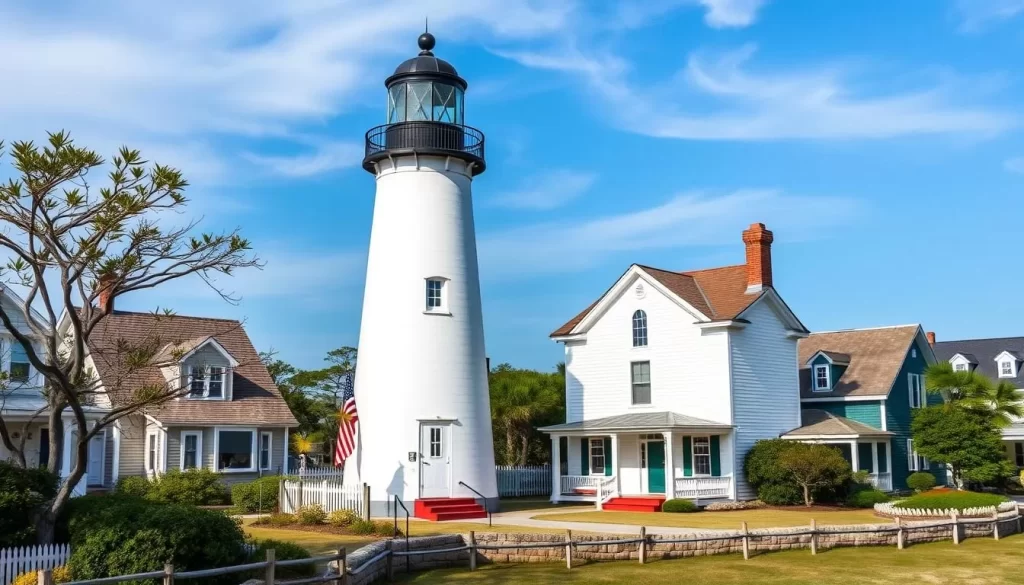
Ocracoke Island is a hidden gem within Cape Hatteras National Seashore, offering a unique blend of history, natural beauty, and adventure. The Ocracoke Lighthouse, built in 1823, is the oldest operating lighthouse in North Carolina and the second oldest in the United States, standing 75 feet tall with its distinctive solid white exterior.
Unlike the other lighthouses in Cape Hatteras National Seashore, the Ocracoke Lighthouse is not open for climbing, but visitors can explore the grounds and exterior of this historic structure. Ocracoke Island is accessible only by ferry, adding to its remote charm and making a visit feel like a true adventure—you can take the free Hatteras Inlet Ferry (45 minutes) or the longer Cedar Island or Swan Quarter ferries (2-3 hours).
The charming Ocracoke Village features narrow streets lined with live oaks, unique shops, art galleries, and restaurants serving fresh seafood, creating a quaint atmosphere that feels worlds away from mainland hustle. Ocracoke Island has a rich history, including serving as a hideout for the infamous pirate Blackbeard, who met his end in a naval battle just off the island’s shores in 1718.
The island’s 16-mile stretch includes some of the most pristine beaches in the national seashore, with Ocracoke Beach consistently ranked among the best beaches in the United States.
Award-Winning Beaches for Every Visitor
The beaches of Cape Hatteras National Seashore are a treasure trove of natural beauty, offering something for every kind of visitor. With miles of clean sand and gentle waves, these beaches have earned recognition from top travel publications like Travel + Leisure and Coastal Living.
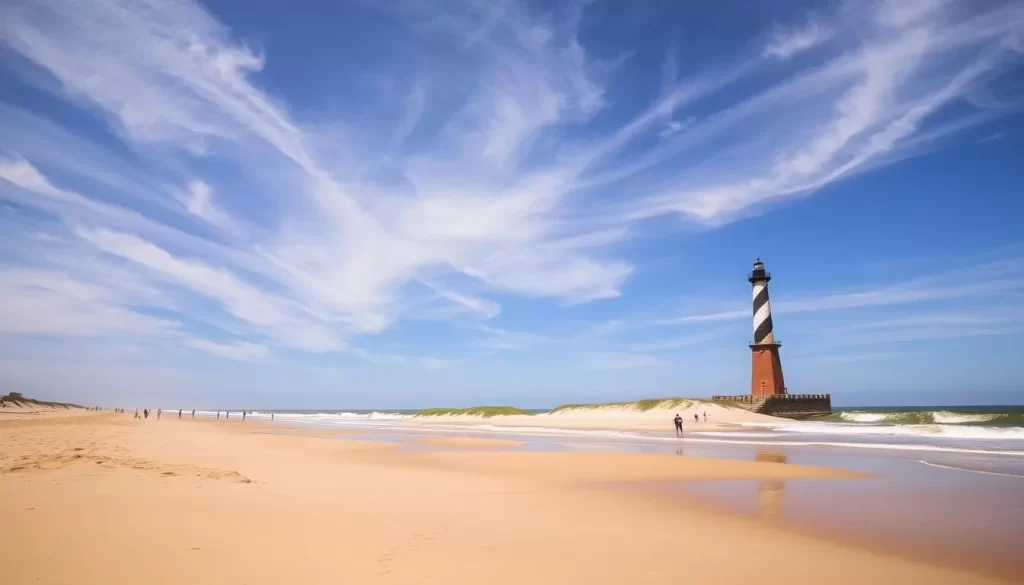
One of the standout features of Cape Hatteras National Seashore is its diverse range of beaches. You can enjoy the more popular spots like Coquina Beach on Bodie Island and Frisco Beach on Hatteras Island, or explore the secluded stretches between villages where you might be the only visitor for miles. This variety ensures that every visitor can find a beach that suits their preferences.
- Four lifeguarded beaches (Coquina Beach, Frisco Beach, Old Lighthouse Beach, and Ocracoke Beach) provide safer swimming options during the summer months, making them ideal for families and less experienced swimmers.
- The unique geography of the seashore creates varied beach experiences—the south-facing beaches near Buxton and Frisco offer warmer water and gentler waves, while the east-facing beaches provide more dramatic surf conditions.
- Beyond swimming, the beaches are perfect for shelling (especially after storms), beachcombing for sea glass, building sandcastles, or simply relaxing with a book under an umbrella.
- The wide, flat beaches make for excellent walking and jogging paths, with the opportunity to cover miles of shoreline while enjoying unobstructed ocean views and spotting coastal wildlife.
Whether you’re looking for adventure or relaxation, the beaches of Cape Hatteras National Seashore have it all. With their pristine condition and diverse offerings, it’s no wonder that they are a top destination for beach lovers. So, pack your bags and get ready to experience the beauty and tranquility of these award-winning beaches.
World-Class Fishing Opportunities

Cape Hatteras stands out as a premier fishing destination, thanks to its nutrient-rich waters and the meeting of the Gulf Stream and Labrador Current. This unique geography creates an environment that attracts a diverse range of fish species throughout the year, including red drum, bluefish, flounder, sea trout, and king mackerel.
You can enjoy fishing directly from the beach along the entire Cape Hatteras National Seashore, from piers like the Avon Fishing Pier, or take charter boats for offshore adventures targeting larger game fish. The area is particularly celebrated for its surf fishing, with Cape Point in Buxton often cited as one of the best locations on the East Coast.
Fall is a special time for fishing at Cape Hatteras, with the legendary red drum runs bringing anglers from across the country. To fish, you’ll need a North Carolina Coastal Recreational Fishing License, available online or at local tackle shops that also offer advice on current hot spots and preferred baits.
The fishing community at Cape Hatteras is welcoming, with many local shops offering equipment rentals and friendly advice to help you land a fish from these productive waters.
Cape Hatteras National Seashore, North Carolina: Best Things to Do – Top Picks
Cape Hatteras National Seashore, with its iconic lighthouses and pristine beaches, is a paradise for nature lovers and history enthusiasts alike. Located on Hatteras Island, this national seashore offers a diverse range of activities and breathtaking landscapes that cater to all kinds of visitors.
You can start your adventure by climbing the Cape Hatteras Lighthouse, a 198-foot tall structure that offers unparalleled views of the surrounding seashore and a glimpse into the area’s maritime history. The lighthouse is not just a visual treat but also a historical landmark that signifies the importance of maritime navigation in the region.
Another must-visit attraction is the Graveyard of the Atlantic Museum near the Hatteras ferry docks. The museum provides fascinating insights into the more than 600 shipwrecks that have occurred off these shores, with exhibits featuring authentic artifacts and a 12-foot lighthouse lens. It’s a great place to understand the maritime history and the challenges faced by sailors and navigators.
For a day trip, consider taking the free ferry to Ocracoke Island. This charming island is home to the Ocracoke Lighthouse, a quaint village, and some of the most pristine beaches in the national seashore. You can explore the island, enjoy the local cuisine, and soak in the relaxed atmosphere.
If you’re a wildlife enthusiast, the Pea Island National Wildlife Refuge is a must-visit. Located on the northern part of Hatteras Island, this refuge is home to over 400 bird species and offers excellent opportunities for birdwatching, photography, and connecting with nature.
The waters around Cape Hatteras National Seashore are perfect for various water sports. You can enjoy surfing at spots like S-Curves and Old Lighthouse Beach, kiteboarding and windsurfing at Canadian Hole, and kayaking through calm sound waters. These activities provide a thrilling way to experience the natural beauty of the Outer Banks.
For a unique experience, consider beach driving with a proper permit. This allows you to access remote fishing spots and secluded beaches, creating a unique way to experience the natural beauty of the Outer Banks away from more populated areas.
You can also explore the seashore on horseback with guided tours through Buxton Woods and along the beach. This offers a magical perspective of the seashore’s diverse landscapes, from maritime forests to open shoreline.
Here’s a summary of the top activities and their locations:
| Activity | Location |
|---|---|
| Climbing the Cape Hatteras Lighthouse | Cape Hatteras |
| Visiting the Graveyard of the Atlantic Museum | Near Hatteras Ferry Docks |
| Ferry to Ocracoke Island | Hatteras Island |
| Exploring Pea Island National Wildlife Refuge | Pea Island |

In conclusion, Cape Hatteras National Seashore offers a wide range of activities that cater to different interests. Whether you’re a history buff, a nature lover, or an adventure seeker, you’ll find something that suits your taste in this beautiful national seashore.
Thrilling Water Sports Adventures
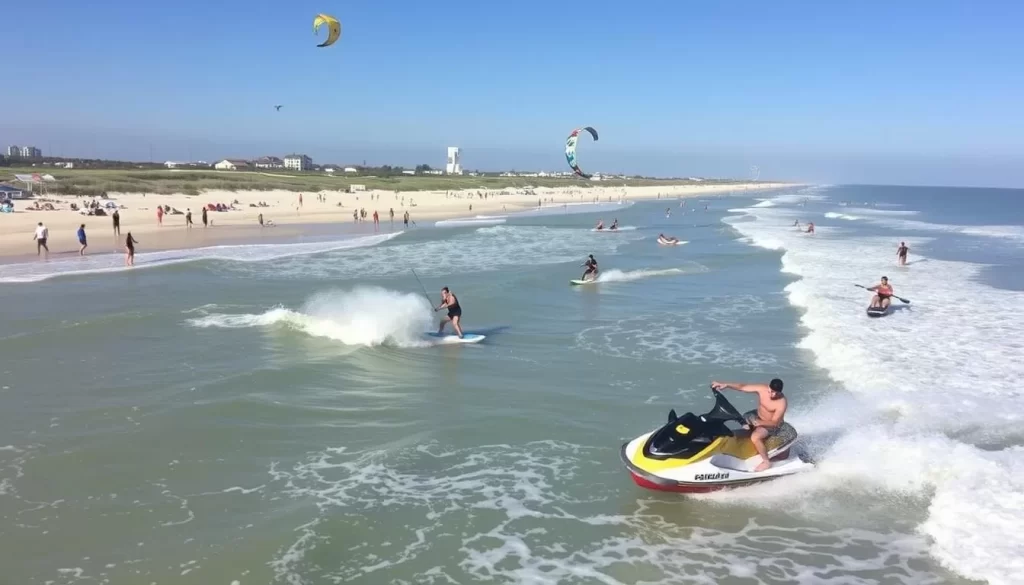
Cape Hatteras National Seashore is renowned for its exciting water sports opportunities. The consistent winds and varied water conditions create perfect environments for multiple activities, making it a world-renowned destination for water sports enthusiasts.
Surfing thrives along the seashore, with spots like S-Curves north of Rodanthe and Old Lighthouse Beach in Buxton offering some of the best breaks on the East Coast. Both beginners and professional surfers are attracted to these locations.
Kiteboarding and windsurfing have found their mecca at spots like Canadian Hole (between Avon and Buxton) and Kite Point, where steady winds and shallow sound waters create ideal learning and performance conditions.
Kayaking opportunities abound in both the sound and ocean waters. Guided eco-tours are available to explore hidden coves, marshes, and estuaries while spotting local wildlife like herons, egrets, and sometimes dolphins.
Stand-up paddleboarding has gained popularity as a more accessible water sport. The calm sound waters provide perfect conditions for beginners, while the ocean offers more challenging experiences for advanced paddlers.
Local outfitters throughout Hatteras and Ocracoke Islands offer equipment rentals, lessons, and guided experiences for all water sports, making it easy for visitors of any skill level to try something new during their stay at Cape Hatteras National Seashore.
Wildlife Refuges and Natural Wonders
Spanning 13 miles of Hatteras Island, the Pea Island National Wildlife Refuge is a paradise for birdwatchers and nature photographers. Established in 1938, this refuge protects and preserves the diverse ecosystems of barrier islands, including maritime forests, dunes, freshwater ponds, and salt marshes that support an incredible variety of wildlife.
You can explore the North Pond Wildlife Trail, which offers an accessible 1.2-mile round-trip path with interpretive signs and observation platforms. Here, you can spot turtles, various waterfowl, and even occasional river otters or deer. The trail is a great way to experience the natural beauty of the refuge up close.
| Wildlife Feature | Description | Best Time to Visit |
|---|---|---|
| Bird Species | Over 400 species documented | Spring and Fall Migrations |
| Turtles and Waterfowl | Various species including turtles and ducks | Year-round, especially during migrations |
| Sea Turtles Nesting | Loggerhead, Green, and Kemp’s Ridley turtles | May to September |
The Pea Island National Wildlife Refuge is particularly famous for its birdwatching opportunities, with over 400 bird species recorded. During fall and winter, the refuge comes alive with spectacular migrations of snow geese, tundra swans, and various duck species, creating breathtaking scenes for wildlife enthusiasts.
The Visitor Center is a valuable resource, providing educational exhibits, spotting scopes, and knowledgeable staff who can help identify species and suggest the best viewing locations based on recent wildlife activity. Beyond Pea Island, the entire Cape Hatteras National Seashore serves as habitat for nesting sea turtles, with loggerhead, green, and occasionally Kemp’s ridley turtles laying eggs on the beaches between May and September.
Ferry to Ocracoke Island: A Must-Do Adventure

The ferry ride to Ocracoke Island offers a scenic journey across Hatteras Inlet, complete with stunning views and wildlife spotting opportunities. You’ll have the chance to see dolphins and seabirds, making the trip an adventure in itself.
The free Hatteras-Ocracoke ferry operates year-round, running every 30 minutes during peak season. The crossing takes approximately 45 minutes, and you can simply drive up and board the next available departure without needing a reservation.
For those traveling from the mainland, the Cedar Island and Swan Quarter ferries provide alternative routes to Ocracoke Island. These journeys take around 2-3 hours and offer a unique perspective on the Pamlico Sound. Reservations are required for these longer routes.
Once you arrive on Ocracoke Island, you’ll discover 16 miles of pristine beaches, a charming historic village with buildings dating back to the 1700s, and a relaxed pace of life. The island’s compact village is perfect for exploring on foot or by bicycle, with unique shops, restaurants serving fresh seafood, and historic sites like Blackbeard’s former hideout.
To make the most of your trip to Ocracoke Island, plan your ferry trip carefully, especially during summer months when lines can be long. Arriving early in the morning or later in the afternoon can help you avoid peak wait times. Always check the ferry schedule for the last departure if you’re making a day trip to ensure you don’t miss your return journey.
Camping Under the Stars

Under the starry night sky, Cape Hatteras National Seashore transforms into a camper’s paradise. The national seashore offers four developed campgrounds operated by the National Park Service: Oregon Inlet on Bodie Island, Cape Point and Frisco on Hatteras Island, and Ocracoke Campground on Ocracoke Island.
Each campground has its unique character. For instance, Oregon Inlet features sites nestled among dunes with easy beach access, while Cape Point is situated near prime fishing spots. Frisco offers more tree cover and protection from winds, and Ocracoke provides a more remote camping experience.
All campgrounds in the Cape Hatteras National Seashore offer basic amenities, including restrooms, cold showers, grills, and picnic tables. Oregon Inlet additionally provides electric and water hookups for RVs and a dump station, making it a convenient option for those with recreational vehicles.
Camping at Cape Hatteras National Seashore provides unparalleled access to stargazing opportunities. The limited development and distance from major cities result in some of the darkest night skies on the East Coast. For a more primitive experience, beach camping is permitted with a free permit from the National Park Service, allowing you to spend the night directly on the beach in designated areas.
Reservations are highly recommended, especially during the peak summer season, and can be made through recreation.gov up to six months in advance. Whether you’re an avid angler or someone seeking solitude, Cape Hatteras National Seashore offers a camping experience that connects you with nature.
Best Time to Visit and Practical Tips
Cape Hatteras National Seashore is a destination that offers a unique experience throughout the year, but knowing when to go and how to prepare can enhance your visit. The best time to visitCape Hatteras National Seashoredepends on your priorities.
- Summer (June-August) offers the warmest temperatures for swimming but brings larger crowds and higher accommodation rates.
- Spring (April-May) and fall (September-October) provide ideal conditions with mild temperatures, fewer visitors, and often better fishing, though fall carries a slight hurricane risk that visitors should monitor.
- Winter offers a completely different experience with dramatic skies, excellent shelling, and virtually empty beaches, though some businesses operate on reduced hours and ferry schedules are limited.
When planning your trip, consider that the seashore is quite expansive—driving from the northern entrance at Bodie Island to Hatteras Village takes about 1.5 hours without stops. Be prepared for limited cell phone coverage and potential rapid weather changes. Bring essential supplies like sunscreen, insect repellent, drinking water, and appropriate footwear to ensure a comfortable and enjoyable trip toCape Hatteras National Seashore.
By being informed and prepared, you can make the most of your visit to this beautiful national seashore, enjoying the natural beauty and activities thatCape Hatterashas to offer.
Conclusion
With its unique blend of natural beauty and rich history, Cape Hatteras National Seashore is a treasure trove of unforgettable experiences. As you explore the Outer Banks, you’ll discover that this national treasure offers a diverse array of activities and landscapes that cater to all types of travelers.
From the iconic Cape Hatteras Lighthouse to the serene beaches of Hatteras Island, every moment spent here is a testament to the area’s unspoiled charm. The national seashore provides a perfect setting for outdoor adventures, including world-class fishing and thrilling water sports.
The preserved nature of Cape Hatteras National Seashore allows visitors to connect with the coastal environment in a way that’s increasingly rare. Whether you’re seeking adventure, education, or relaxation, this destination delivers. As you plan your trip to this coastal gem, remember to take your time to enjoy the scenic views and historic sites.
In conclusion, Cape Hatteras National Seashore on Hatteras Island is a must-visit destination that promises to leave you with lifelong memories. With its rich history and stunning natural beauty, it’s an ideal location for your next Outer Banks adventure.
The above is subject to change.
Check back often to TRAVEL.COM for the latest travel tips and deals.
